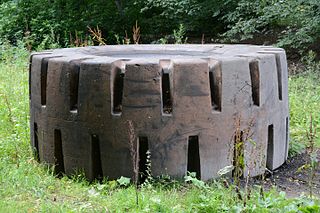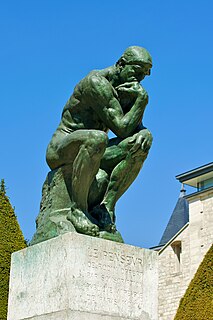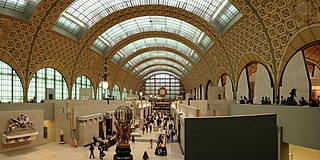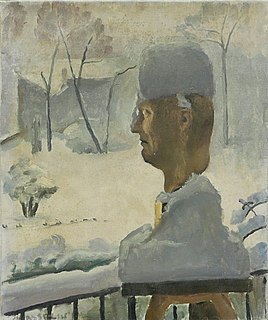
The Louvre, or the Louvre Museum, is the world's most-visited museum, and a historic landmark in Paris, France. It is the home of some of the best-known works of art, including the Mona Lisa and the Venus de Milo. A central landmark of the city, it is located on the Right Bank of the Seine in the city's 1st arrondissement. At any given point in time, approximately 38,000 objects from prehistory to the 21st century are being exhibited over an area of 72,735 square meters. Attendance in 2021 was 2.8 million due to the COVID-19 pandemic, up five percent from 2020, but far below pre-COVID attendance. Nonetheless, the Louvre still topped the list of most-visited art museums in the world in 2021.

Théodore Chassériau was a Dominican-born French Romantic painter noted for his portraits, historical and religious paintings, allegorical murals, and Orientalist images inspired by his travels to Algeria. Early in his career he painted in a Neoclassical style close to that of his teacher Jean-Auguste-Dominique Ingres, but in his later works he was strongly influenced by the Romantic style of Eugène Delacroix. He was a prolific draftsman, and made a suite of prints to illustrate Shakespeare's Othello. The portrait he painted at the age of 15 of Prosper Marilhat, makes Théodore Chassériau the youngest painter exhibited at the Louvre museum.

The Musée de l'Homme is an anthropology museum in Paris, France. It was established in 1937 by Paul Rivet for the 1937 Exposition Internationale des Arts et Techniques dans la Vie Moderne. It is the descendant of the Musée d'Ethnographie du Trocadéro, founded in 1878. The Musée de l'Homme is a research center under the authority of various ministries, and it groups several entities from the CNRS. The Musée de l'Homme is one of the seven departments of the Muséum national d'histoire naturelle. The Musée de l'Homme occupies most of the Passy wing of the Palais de Chaillot in the 16th arrondissement. The vast majority of its collection was transferred to the Quai Branly museum.

The Musée du Quai Branly – Jacques Chirac, located in Paris, France, is a museum designed by French architect Jean Nouvel to feature the indigenous art and cultures of Africa, Asia, Oceania, and the Americas. The museum collection comprises more than a million objects, of which 3,500 are on display at any given time, in both permanent and temporary thematic exhibits. A selection of objects from the museum are also displayed in the Pavillon des Sessions of the Louvre.
Michel Laclotte was a French art historian and museum director, specialising in 14th and 15th century Italian and French painting.

The Pavillon de Flore, part of the Palais du Louvre in Paris, France, stands at the southwest end of the Louvre, near the Pont Royal. It was originally constructed in 1607–1610, during the reign of Henry IV, as the corner pavilion between the Tuileries Palace to the north and the Louvre's Grande Galerie to the east. The pavilion was entirely redesigned and rebuilt by Hector Lefuel in 1864–1868 in a highly decorated Napoleon III style. Arguably the most famous sculpture on the exterior of the Louvre, Jean-Baptiste Carpeaux's Triumph of Flora, was added below the central pediment of the south facade at this time. The Tuileries Palace was burned by the Paris Commune in 1871, and a north facade, similar to the south facade, was added to the pavilion by Lefuel in 1874–1879. Currently, the Pavillon de Flore is part of the Musée du Louvre.

Jean-Michel Othoniel is a French contemporary artist. He lives and works in Paris.

Tourism in Paris is a major income source. Paris received 12.6 million visitors in 2020, measured by hotel stays, a drop of 73 percent from 2019, due to the COVID-19 virus. The number of foreign visitors declined by 80.7 percent. Museums re-opened in 2021, with limitations on the number of visitors at a time and a requirement that visitors wear masks.

The Musée d'Ethnographie du Trocadéro was the first anthropological museum in Paris, founded in 1878. It closed in 1935 when the building that housed it, the Trocadéro Palace, was demolished; its descendant is the Musée de l'Homme, housed in the Palais de Chaillot on the same site, and its French collections formed the nucleus of the Musée National des Arts et Traditions Populaires, also in the Palais de Chaillot. Numerous modern artists visited it and were influenced by its "primitive" art, in particular Picasso during the period when he was working on Les Demoiselles d'Avignon (1907).

Michel François is a Belgian artist. He lives and works in Brussels, Belgium.

For centuries, Paris has attracted artists from around the world, arriving in the city to educate themselves and to seek inspiration from its artistic resources and galleries. As a result, Paris has received a reputation as the "City of Art". Home to some of the world's most famous museums and galleries, including the Louvre and the Musée d'Orsay, the city today remains home to a thriving community of artists. Paris is recognized globally for its public landmarks and masterpieces of architecture including the Arc de Triomphe and a symbol of France, the Eiffel Tower.

Albert Lebourg, birth name Albert-Marie Lebourg, also called Albert-Charles Lebourg and Charles Albert Lebourg, was a French Impressionist and Post-Impressionist landscape painter of the Rouen School. Member of the Société des Artistes Français, he actively worked in a luminous Impressionist style, creating more than 2,000 landscapes during his lifetime. The artist was represented by Galerie Mancini in Paris in 1896, in 1899 and 1910 by : Galerie Bernheim-Jeune, 1903 and 1906 at the Galerie Paul Rosenberg, and 1918 and 1923 at Galerie Georges Petit.

Didier Ottinger, born in Nancy in 1957, is a French museum curator, art critic and author. He is known for organizing exhibitions and publishing books on modern and contemporary painting. He is now assistant director of the Centre Pompidou at the Musée national d'art moderne in Paris.
Frédéric Sanchez is a French sound artist and music producer, best known for his career in the fashion industry. His works include sound collages, mixes, original compositions, and sound installations. Major industry observers such as Vogue, Dazed, AnOther, or Business of Fashion have repeatedly referred to him as "one of the most respected sound designers working today".
Quentin Bajac is a French museum curator and art historian specialising in the history of photography. He is the director of the Galerie nationale du Jeu de Paume in Paris.

The 136 museums in the city of Paris display many historical, scientific, and archeological artifacts from around the world, covering diverse and unique topics including fashion, theater, sports, cosmetics, and the culinary arts.

Rubin's Europe was a temporary exhibition at the Louvre-Lens which took place in the temporary exhibitions gallery from May 22 to the September 23, 2013, following the inaugural Renaissance exhibition. The exhibition brought together 170 works by Pierre Paul Rubens and his contemporaries, the majority of which were on loan from other museums.
Jacques Giès was a French sinologist and art historian. He served as President of the Guimet Museum from 2008 to 2011.
Thierry Zéphir is a French research engineer at the Guimet Museum, and a specialist in Khmer art and the Indianized world.

Maurice Paul Jean Asselin was a French painter, watercolourist, printmaker, lithographer, engraver and illustrator, associated with the School of Paris. He is best known for still lifes and nudes. Other recurring themes in his work are motherhood, and the landscapes and seascapes of Brittany. He also worked as a book illustrator, particularly in the 1920s. His personal style was characterised by subdued colours, sensitive brushwork and a strong sense of composition and design.















